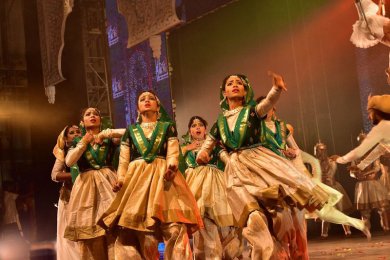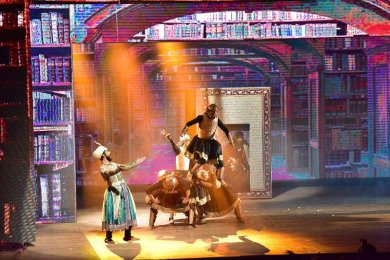
|   |

|   |
 e-mail: ukb7@rediffmail.com Many and Mono July 5, 2018 This metropolis saw, in quick succession, two quality productions with mixed media: a multi-starrer spectacular - with nearly a hundred actors - - as an audio-visual extravaganza and the other a lonely monologue of a hapless girl led astray by an unkind world. Interestingly, both productions had credible choreographic inputs by Sudarshan Chakravorty, who steers Sapphire Creations. Kohinoor Photos: Sourendro Soumyojit Kohinoor, arguably the most famous and yet the most ill-fated diamond from India, has its origins steeped into antiquity. Literally meaning "the Mountain of Light" in Persian lingo, Kohinoor has its mythology going back to 'Syamantaka' - - adorning Krishna's crown - - in the Mahabharata times, but historically it is presumed to be dug up from the mines of Golconda and belonged to the Emperor of Delhi, Allaudin Khilji in 1304. In 1339, the diamond was taken back to the city of Samarkand, where it stayed for almost 300 years and, according to parables, a curse was placed on the men who would wear the diamond: "He who owns this diamond will own the world, but will also know all its misfortunes. Only God, or a woman, can wear it with impunity." Whatever, in 1526 the Mughal ruler Babur mentions the diamond in his memoirs, Baburnama, as a gift by the Sultan Ibrahim Lodi. Babur was the one who described the diamond's value equal to half-day production costs of the world! Down the Mughal dynasty, Muhamad Shah 'Rangoli', the grandson of Aurangazeb, however, was not a great ruler like his grandfather and was attacked by the fearsome Persian general Nadir Shah in 1739. He wanted to conquer the throne, which had been weakened during the reign of Sultan Muhamad. The Sultan lost the decisive battle and had to surrender to Nadir. But Nadir Shah did not live for long, since in 1747 he was assassinated and the diamond got to one of his generals, Ahmad Shah Durrani. In an interesting role reversal, a descendant of Ahmad Shah, Shah Shuja Durrani brought the Kohinoor back to India in 1813 and gave it to Ranjit Singh, the founder of the Sikh Empire. In exchange, Ranjit Singh helped Shah Shuja get back the throne of Afghanistan. History now records Daleep Singh, the young scion of Ranjit gifting Kohinoor to Queen Victoria in 1850 and the great gem cut to shape. Having worn it a few times, the Queen consigned it to the Crown Jewels in the Tower Museum. 



Kohinoor the Musical, presented on June 21 by the musician duo Sourendra Mullick and Soumyajit Das, was a most enjoyable repast based on the above storyline, barring its mythological allusion. Built lavishly on the model of West End and Broadway musicals, the show seemingly followed the narrative, Koh-i-Noor, the History of the World's Most Infamous Diamond, by William Dalrymple and Anita Anand, based on arguably the first comprehensive and authoritative history of this world famous jewel. The spectacle kicks off with the Khilji miners vigorously digging up the diamond mines. There are mortal clashes between the Turk-Afghans and Babur's army, and the subsequent looting of the Nizam's treasury. Kohinoor, reflected in a mortal form - played delectably by the talented, young aerobatic dancer Pallabi Haldar - passes literally from hand to hand, now to the great Mughals. Soumyajit's competent commentary and a highly ingenious musical compering provide the needed link, together with Sudarshan's imaginative choreography. The Kathak dancers create the right milieu of the Mughal Durbar's grandeur and the ambience created by a fair replica of the Mayur Simhasan (peacock throne) mirrors a dreamy ambience. Nadir Shah's violent assault on the Delhi dynasty and Muhamad Shah's recapitulation - with the consequent loss of the fabled throne and the tussle with the diamond - come through vividly, with a charming Sufi dance sequence at the culture loving court. The jewel goes back to the Middle East, only to be retrieved by the Sikh stalwart Ranjit Singh. According to the latter's last wish, Kohinoor was destined to reach Jagannath temple, which was not to be. The British characters in the segment touching Lord Dalhousie of the East India Company and Empress Victoria of England, are played with gusto by Jay Treloar and Sybilla de Uray Ura - - of American and Hungarian origin respectively - - complete with Sybilla's full-throated soprano singing. One must mention about the brilliant lighting by Dinesh Poddar that created magic in the optics of the sets, ranging from the sumptuous durbar awnings to the Victorian court decorations of imperial England. Costumes equally matched imagination, with the opulence of the medieval grandeur in a picture perfect manner. The music was suitably far-ranging, suiting the mood of the period. Kohinoor's final lamentation about its near human predicament - to have been tossed around from hand to hand in the entire recorded history - narrated in actor Sharmila Tagore's voice, was quite captivating. In a nutshell, this critic would have ample reasons to heartily endorse the show's forthcoming all-India and foreign tours. Rangini Photos: Friends Communication Rangini presented on June 22 by Friends Communication and directed by Ujjal Chattopadhyay, was a unique solo presentation of a complex feminist theme. It would be entirely untrue to regard her story as the downhill regression of a hapless girl seduced into pregnancy by a wanton youth. Quite to the contrary, it was the brave narration of an untutored rustic maiden - - once tricked - - to stand up, collect the bits and pieces of her happy (and not so happy) recollections, and face the world with a renewed determination, together with her unborn child. As admitted by the protagonist Gargee Roychoudhury - a well-known theatre and film persona in Bengal, "It's the story of a village girl who comes to the city, and is betrayed by her lover. The story progresses through tortuous events. In a monologue play, I wanted to challenge myself..." 

Indeed, right from the word go, Gargee takes matters in hand and merges her reel and stages self with her real self. She animatedly narrates her last puja memory in her hometown and her first encounter with her idol Badol - also her future seducer - who, seeing her once in tears, gallantly offered her a dry handkerchief. Rangini trusts herself to Badol who brings her to an unknown city and, in a series of vignettes, she narrates how she copes with the hostile milieu. With a great gift to sing Tagore and Nazrul songs, thumris and tappas, and songs of modern generation from Kabir Suman and folk composers, and drawing upon her real experience on the stage and in the celluloid world, Gargee freely intersperses her dialogue with superb musical interludes - keeping alive necessary voice modulation. It was praiseworthy to see Gargee don a succession of roles: of the close relative Mejka; Rangini the innocent lass; Badol the rogue who deserted her, once they were in the city; the novice Moina and her mentor Benimadhav who taught her that "Theatre acting was not an art, but a schooling in strict discipline" in the play Teener Talwar; the title-role Nimai in the play Nimai Sannyas; nartaki in the cabaret dance; the flower-girl Nandini and her unfailing companion Bishu Pagal in Tagore's play Rakta Karabi; and Lalon Sain the saint-poet, as her final resort. All through, she keeps a dialogue on with the love child in her womb, reassuring the unborn one of her love - somewhat like C.A. Pearson's famous tract, Letter to an Unborn Child, which helps us to understand that it is love that may destroy but that, ultimately, it is only love that can heal. At the end, the monologue upholds that "It's the journey of a woman who is determined and untouched by negativity", as asserted by Gargee once. It is, in fact, much more - - it is the woman's journey into the light of love and liberation, into an ultimate triumph...  Dr. Utpal K Banerjee is a scholar-commentator on performing arts over last four decades. He has authored 23 books on Indian art and culture, and 10 on Tagore studies. He served IGNCA as National Project Director, was a Tagore Research Scholar and is recipient of Padma Shri. Post your comments Please provide your name and email id when you use the Anonymous profile in the blog to post a comment. All appropriate comments posted with name & email id in the blog will also be featured in the site. |